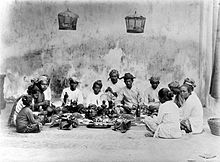
| Part of a series on |
| Anthropology of religion |
|---|
 |
| Social and cultural anthropology |
The slametan (or selametan, slamatan, and selamatan) is the communal feast from Java, symbolizing the social unity of those participating in it. Clifford Geertz considered it the core ritual in Javanese religion, in particular the abangan variant.[1] The feast is common among the closely related Javanese, Sundanese and Madurese people.
A slametan can be given to celebrate almost any occurrence, including birth, marriage, death, moving to a new house, and so forth. Depending on the intention, the mood and emphasis may vary somewhat, but the main structure is the same.[1] Geertz categorizes them into four main types:[2]
- Those relating to the crises of life: birth, circumcision, marriage, and death
- Those associated with events of the Islamic calendar
- The bersih désa ("cleaning of the village"), concerned with the social integration of the village
- Those held irregularly depending on unusual occurrences: departing for a long trip, moving residence, changing personal names, healing from illnesses, recovering from the effect of sorcery, and so on
The ceremony takes its name from the Javanese word slamet, from Arabic: salam, which refers to a peaceful state of equanimity, in which nothing will happen. This is what the host intends for both himself and his guests, by experiencing the egalitarian structure of the slametan and the petitions of supernatural protection from spirits.[3]
In Geertz's fieldwork in Mojokuto in the 1950s, he found that costs of slametans varied from 3 to 5,000 Indonesian rupiahs, depending on the type and the relative wealth of the host.